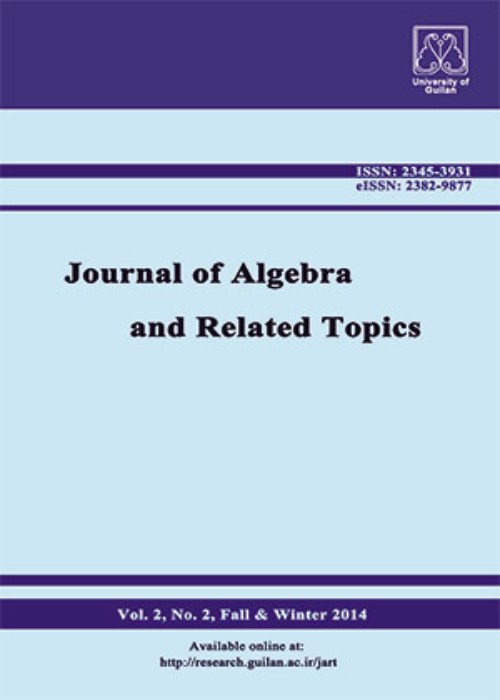فهرست مطالب

Journal of Algebra and Related Topics
Volume:7 Issue: 2, Autumn 2019
- تاریخ انتشار: 1399/04/29
- تعداد عناوین: 6
-
Pages 1-7For every inverse semigroup $S$ with subsemigroup $E$ of idempotents, necessary and sufficient conditions are obtained for the semigroup algebra $l ^{1}(S)$ to be $hat{phi}$-amenable and $hat{phi}$-module amenable. Also, we characterize the character amenability of semigroup algebra $l^1(S)$.Keywords: Banach modules, Inverse semigroup, Semigroup algebras, Module amenability, $phi$-amenability
-
Pages 9-18In this paper, all principal (m , n)-closed ideals and principal semi n-absorbing ideals in the semiring of non-negative integers are investigated.Keywords: Semiring, n-absorbing ideal, (m, n)-closed ideal, semi-n-absorbing ideal
-
Pages 19-30In this paper, we discussed a method to construct a global sheaf space using graphs via Maximal compatibility blocks (MCB's) and we proposed the correspondence between graphs and sheaves. Further we discussed the sheaf constructions for various graphs using MCB's and vice-versa. We also presented some graph theoretical examples for the construction of sheaves.Keywords: Sheaf representation, maximal compatibility blocks, graphs
-
Pages 31-45The Harary spectrum of a connected graph $G$ is the collection of the eigenvalues of its Harary matrix. The Harary energy of a graph $G$ is the sum of absolute values of its Harary eigenvalues. Harary equitable partition is defined and is used to obtain Harary spectrum of generalized composition of graphs. Harary equienergetic graphs have been constructed with the help of generalized composition through Harary equitable partition.Keywords: Harary matrix, Harary spectrum, Harary energy, equitable partition, equienergetic graphs
-
Pages 47-61
Let G be a finite group. For gin G, an ordered pair $(x_1,y_1)in Gtimes G$ is called a solution of the commutator equation $[x,y]=g$ if $[x_1,y_1]=g$. We consider rho_g(G)={(x,y)| x,yin G, [x,y]=g}, then the probability that the commutator equation $[x,y]=g$ has solution in a finite group $G$, written P_g(G), is equal to frac{|rho_{g}(G)|}{|G|^2}. In this paper, we present two methods for the computing P_g(G). First by $GAP, we give certain explicit formulas for P_g(A_n) and P_g(S_n). Also we note that this method can be applied to any group of small order. Then by using the numerical solutions of the equation xy-zu equiv t (mod~n), we derive formulas for calculating the probability of $rho_g(G)$ where $G$ is a two generated group of nilpotency class 2.the formula is not displayed correctly!
Keywords: GAP, Alternating groups, Symmetric groups, Nilpotent groups -
Pages 63-83
We generalize Sepasdar's method for finding a gene- \\rator matrix of two-dimensional cyclic codes to find a generating set and a linearly independent subset of a general multicyclic code. From these sets, a basis of the code as a vector subspace can be deduced or constructed. A generator matrix can be then deduced from this basis.
Keywords: quotient ring, lexicographic order, ideal basis, multicyclic code, generator matrix


